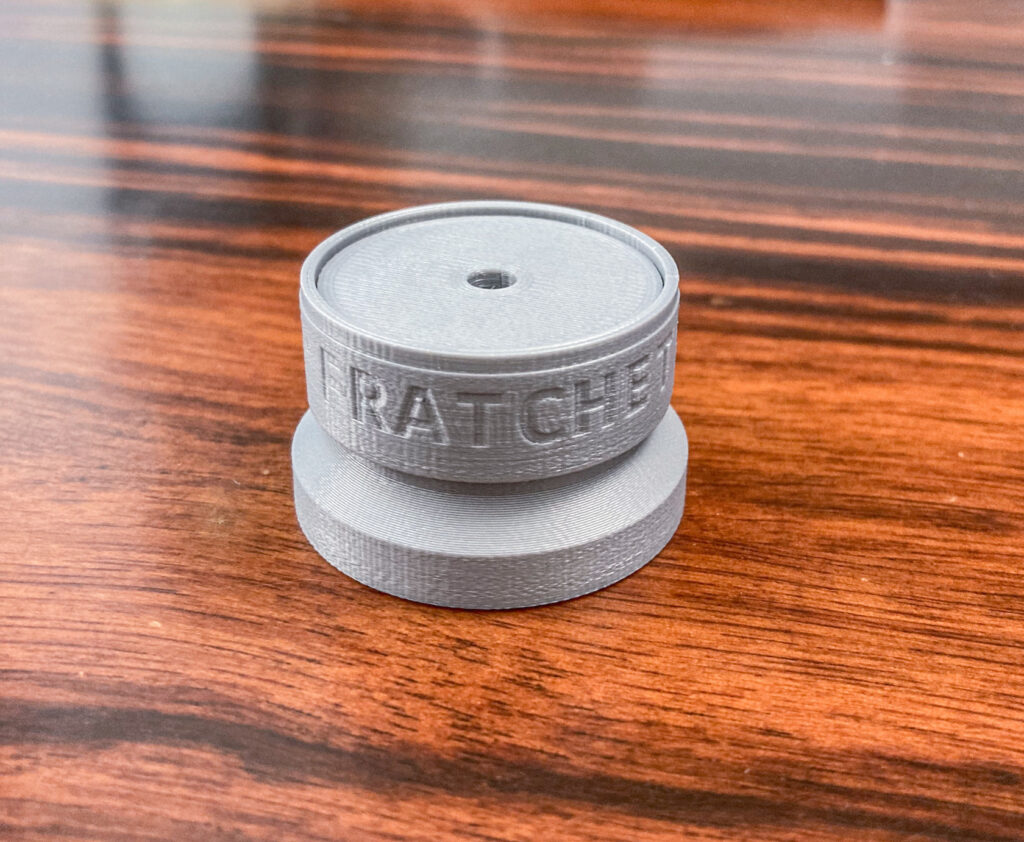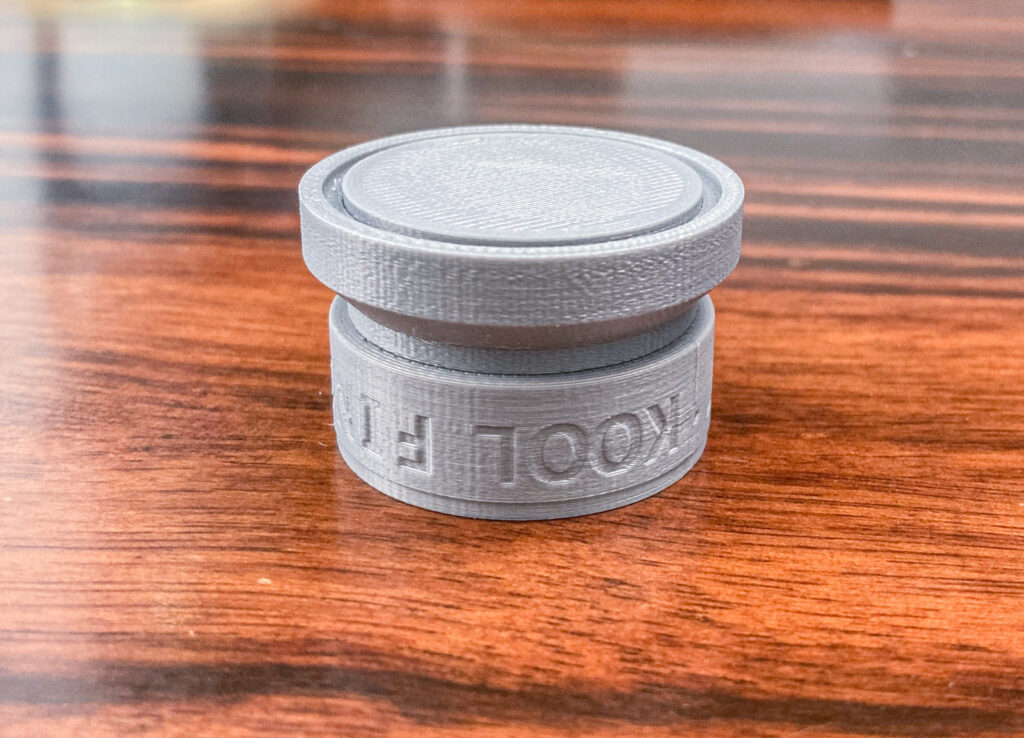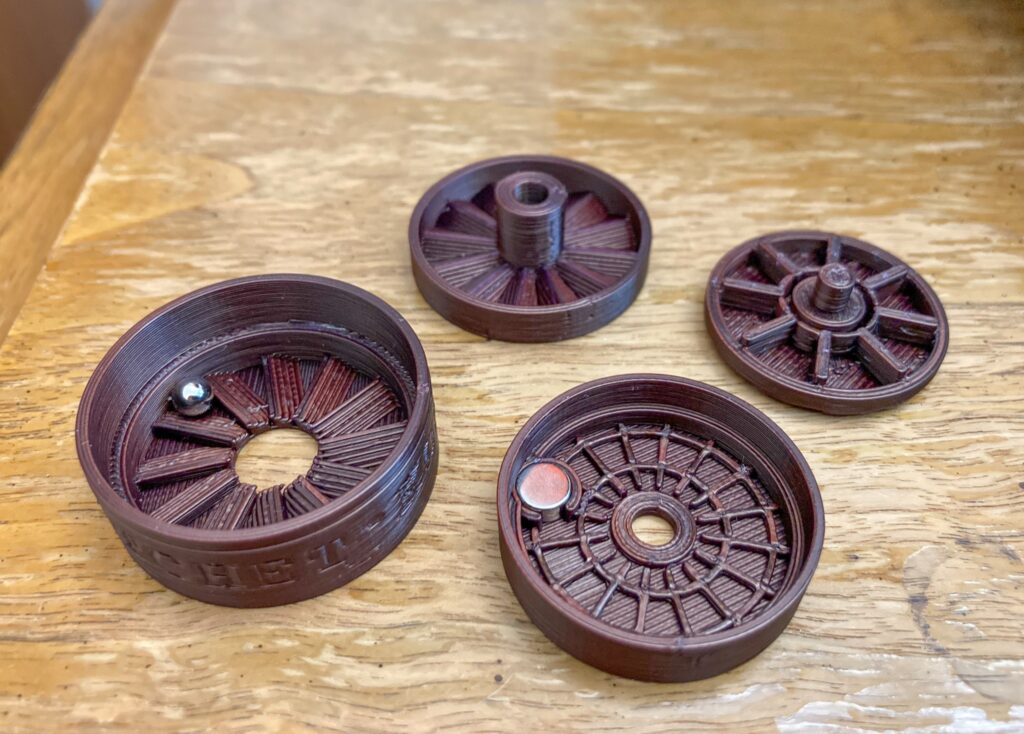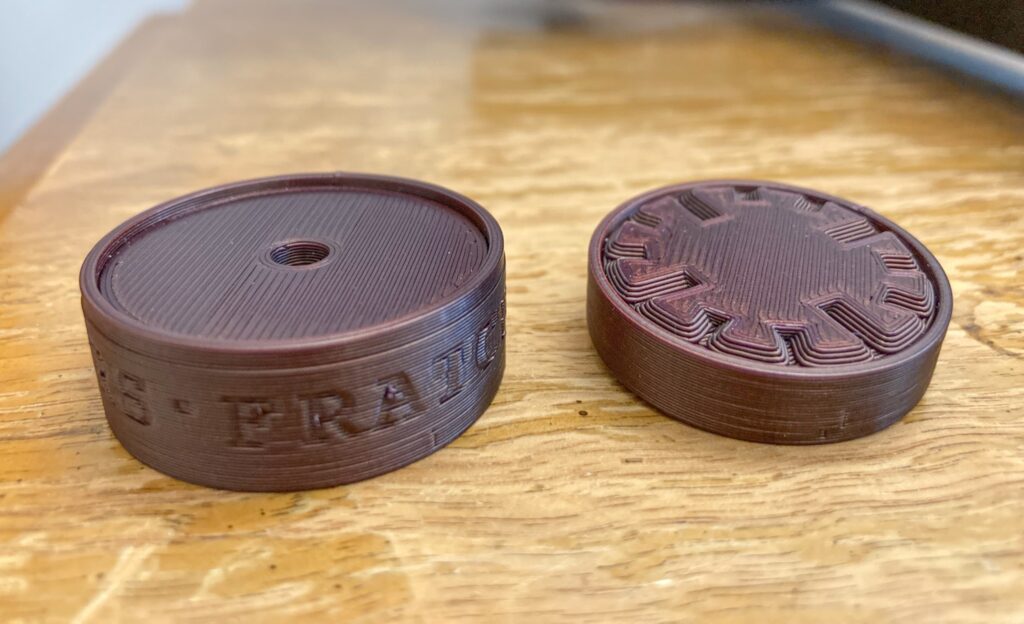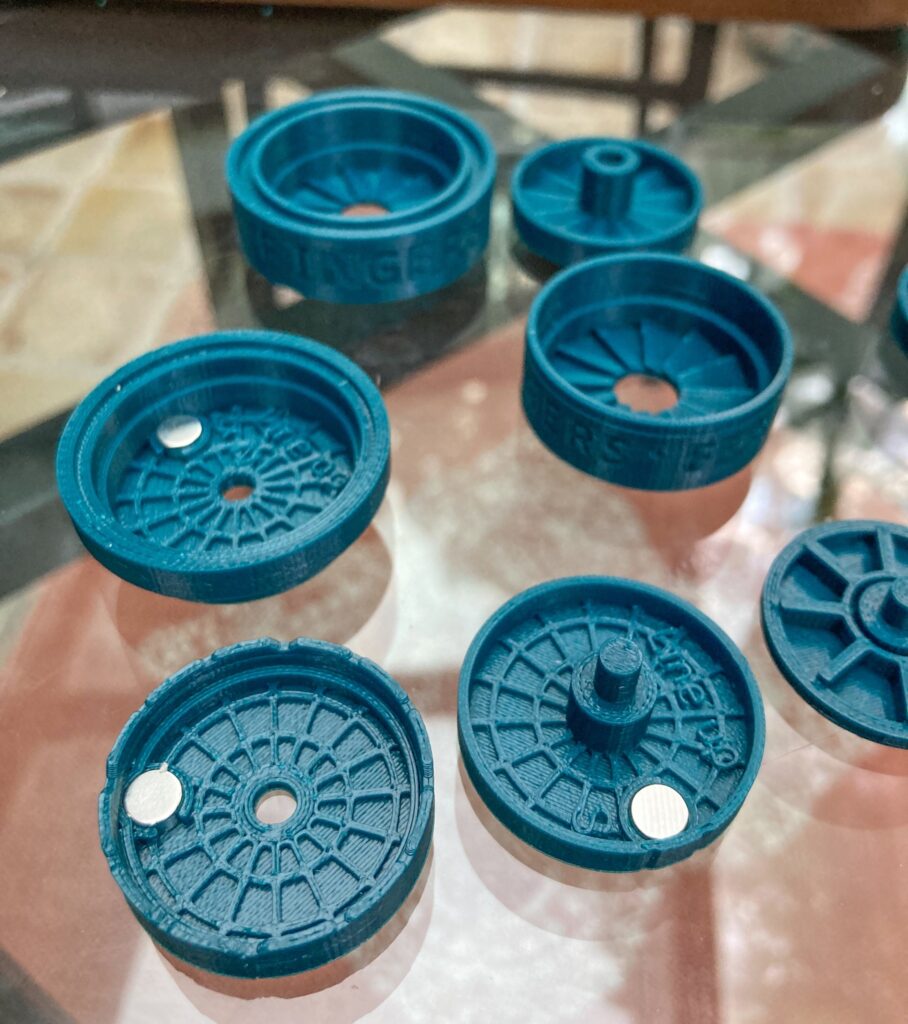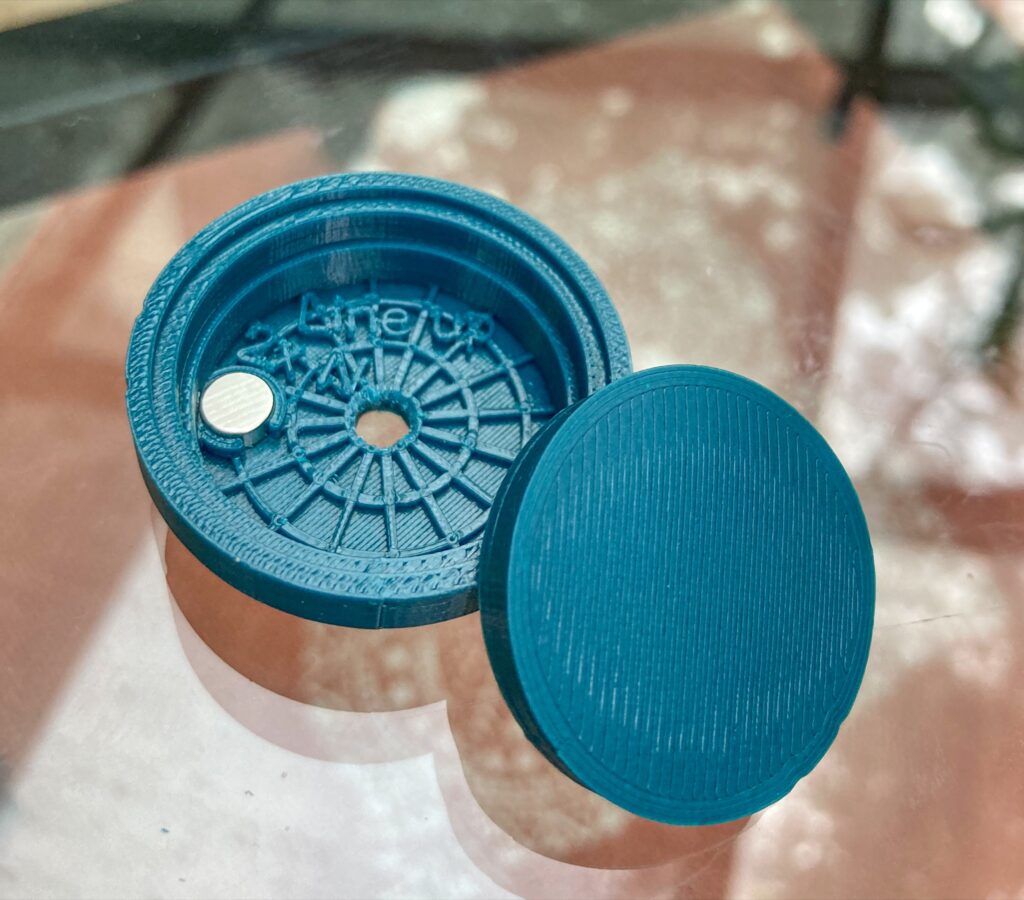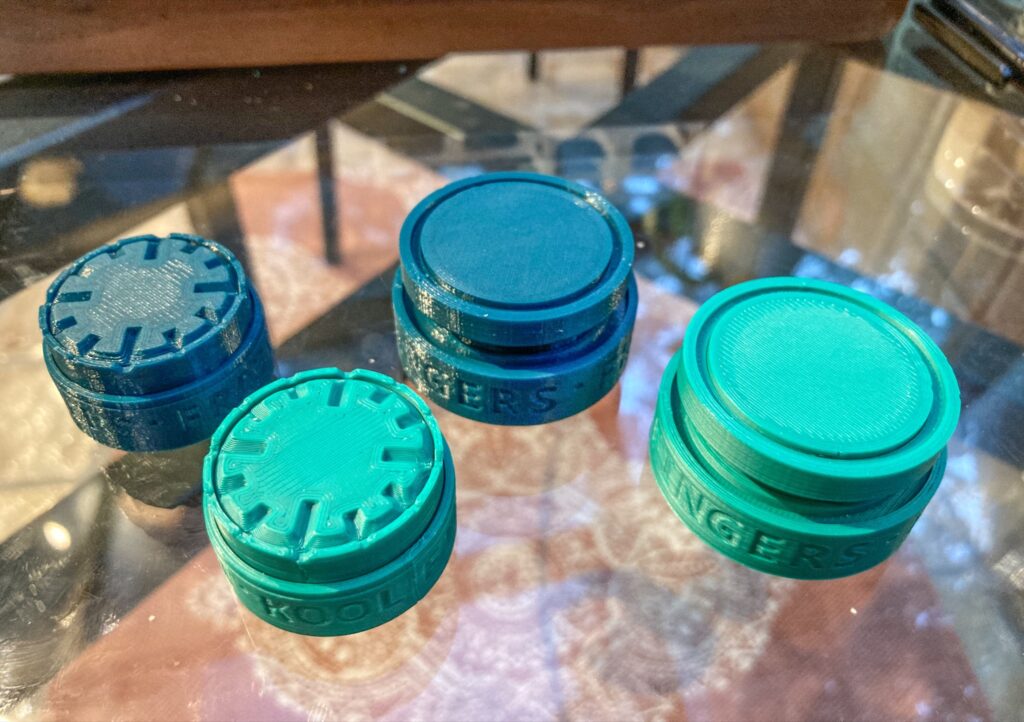Fratchets are fidget ratchets without mechanical springs. Instead they are powered by magnets. But they do feel and sound like socket wrenches, cog rattle, and ratchet strap buckles.
Despite their sophisticated sound and haptic feedback, they are quite simple: a bunch of 3d-printed parts snapped together to capture magnets inside them. Some very smart people say you can’t make fidgets simpler than these. We came up with these, and hold pending patents on the concept of fidget walkers – think “walking a magnet with another magnet over a largely uneven surface”.
You can print fratchet coins and knobs for personal use. Feel free to build on them as well for non-commercial uses. They go under CC BY-NC-SA 4.0 as detailed at our main 3D-prints page. More on licensing later.
This package contains STL parts for a thumb coin you can roll with just a thumb, and a hand knob that you can grip and operate with multiple fingers. Each fratchet consists of a dial and a base. The coin dial comes with a standard base, and the knob dial a large base. But the coin dial can be used with either side of the large base, for altered ratcheting feedback. And either side of the knob dial works with either side of the standard base. There are also 3MF files for slicer apps we have used ourselves, which you may find useful. These fratchet models are available on Amazon for those who can’t print, or can’t be bothered to get the right magnets. See later sections.

Table of Contents
Download from these platforms
- https://www.thingiverse.com/thing:6255028
- https://www.printables.com/model/607023
- https://cults3d.com/:1500468
- https://makerworld.com/en/models/36640
Magnets required for Fratchets
Each dial has embedded in it one or more disc magnets. The disc magnet needs to be of specific dimensions to fit a magnet holder inside the dial. Each base encloses a moving ball magnet inside its base body. Any magnet that fits the base body can be used as the inside magnet. The shape, the size and the magnetic strength of the inside magnet affect tactile and acoustic feedback.
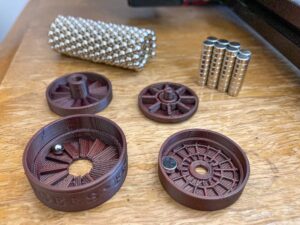
DIAL MAGNET: one or more 6mm x 3mm N35 neodymium disc magnets. Most disc magnets found online actually measure 6mm x 2.67mm – these are usable too. Many disc magnets are sold without explicit specs for their strength. Most of these are N35.
INSIDE MAGNET: We recommend a 5mm N35 neodymium ball magnet as the inside magnet. For most PLA prints, this produces a deep bass sound and a satisfactory haptic experience. These are the original Buckyballs, and are no longer easily found online. But you will likely not find exact 5mm magnets. Many magnets sold under the “5mm-diameter” label are actually 3/6″ (4.76mm) ball magnets – they are weaker. But if that’s all you’ve got, then use them. You may also pop in a 1/4″ (6.3mm) N52 neodymium ball magnet instead. These make turning the dial harder, in our opinion. But perhaps you will like it. You can also substitute ball magnets with disc magnets, and even cube magnets, for different types of fidget walker feedback.
Fratchets on our Amazon store are furnished with the 6mmx3mm N35 neodymium disc magnet and the 5mm N35 neodymium ball magnet we recommend. You can purchase these fratchets at our Amazon store.
Warning: swallowed small magnets can stick together across intestines causing serious infections and death. Seek immediate medical attention if magnets are swallowed or inhaled.
Suggested print settings
Always go to our Kool Fingers website for the most up-to-date printing instructions. And remember that there are readme files next to 3MF files for common slicer apps. These fratchet models have been designed with very specific fit tolerance, to make these pieces fit tightly but not too much that you can’t snap them together. Here are some general considerations:
* Print with PLA. But they also work with PETG, ABS, etc.
* They work best printed with 04mm nozzles
* Use a 0.15mm layer print profile
* Specifically, use a 0.2mm first layer height
* and the a 0.15mm height for all subsequent layers
* Top shell layers: 7
* Top shell thickness: 0.7 mm
* Bottom shell layers: 0.5
* Bottom shell thickness: 0.5 mm
* Detect thin walls: ON
* Sparse infill density: 30%
* Sparse infill pattern: Gyroid or Grid
Post-print processing
There is no need for post-print processing, except occasional cleaning of stray strings, and deburring of rugged edges and print defects.
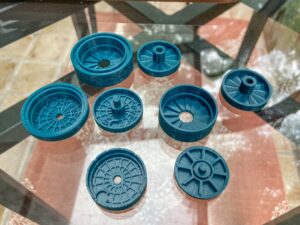
Assembling a Fratchet
The “Thumb Coin” dial and the “Hand Knob” dial have different disc magnet arrangements. The coin dial only requires one disc magnet, and presents only one usable surface for “dialing” (or walking) the inside magnet in a base unit. The knob dial presents two usable surfaces, with 3 disc magnets captured inside, aligned along the same flux line.
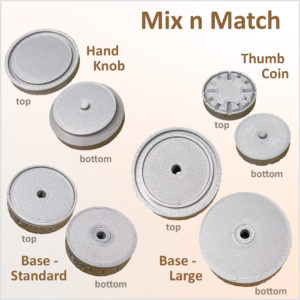
The orientation of the disc magnet in a coin dial is not important. You can place a magnet into the magnet holder with the North up or the South up. Once the magnet is in place, you place the top part on the bottom part, and align the sun ray lines on the top part with notches on the rim of the bottom part. Align long rays with deeper notches. Then you snap the top part into the bottom part.
With the knob dial, you need to pay attention to the orientation of disc magnets. There are labels inside the top part and the bottom part indicating proper orientations of magnets. The bottom part receives two disc magnets with North facing up – thus the label “2x N”. The top part receives one disc magnet with South facing up – thus the label “S”. Some disc magnets are slimmer than others. If needed, you can print out a “Magnet Airgap Filler” part (there is an STL file for it), which you would place atop the two North-facing magnets on the bottom part. Before you snap the top and the bottom together, line up magnets in the two parts so they are on the same flux line. Use the two groove lines printed on rims of both parts to align them. Then you snap the top part into the bottom part.
There are two base units – standard and large. They are assembled the same way. Put a ball magnet into them, and snap a top part into a bottom part.
Licensing
We encourage you to tinker with fratchets. Print them out with different materials. We’ve printed them in PLA, ABS, PETG, PVB, and even ColorFabb BronzeFill metal filament. Every material type produces different magnet vibrations and ratcheting feedback. Find out which ones you like. Tape the fratchet to a sonorous surface such as a window pane or your bathroom door. Ot tape it to a Tupperware container, or to your guitar. Try using different inside magnets. The possibilities are endless.

Fidget Walkers Kool Fingers is licensed under Attribution-NonCommercial-ShareAlike 4.0 International. To view a copy of this license, visit http://creativecommons.org/licenses/by-nc-sa/4.0/.
Utility patent applications for fidget walkers and related concepts have been filed. Some are early-published and can be found at https://koolfingers.com/patents/. As already covered in our applications, these haptic fidgets are also applicable in a variety of fields including percussion instruments, underwater switches, magnetic locks, tabletop games, and even automated machineries.
Therefore, in addition to “CC BY-NC-SA 4.0”, all 3D models published here, their future derivations by third-parties, as well as non-derivative work are also covered by pre-issuance provisional rights, as long as the fidget walker concept applies. While you are free to create and print derivative designs, you must not commercialize them without our agreement.
Useful links
All our 3D-printable models
https://koolfingers.com/3d-prints/
Fidget walkers available on Amazon for purchase:
https://www.amazon.com/koolfingers
Up-to-date printing instructions for printing fratchets:
https://koolfingers.com/3d-prints/printing-fratchets/
YouTube videos:
https://www.youtube.com/@KoolFingersLLC
Patent applications:
https://koolfingers.com/patents/
KoolFingers.com 2023 FRTC-v05

